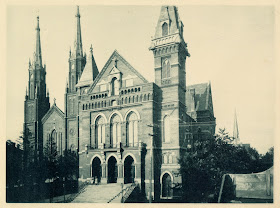by Tom Castaldi
Thanks to Horace Rockwell, the first known itinerant
artist to visit and make a living in Fort
Wayne, we have the Samuel Hanna Family portrait in the
Fort Wayne Museum of Art’s collection. An
oil painting on canvas, Hanna commissioned Horace Rockwell in 1843 to paint the
piece that measures slightly over five feet square. It depicts the prominent Fort Wayne Hanna family
grouped around a table in a conversational setting. Judge Samuel Hanna was an important pioneer
considered to be the father of Fort
Wayne and responsible for the community’s development
bringing the canal, railroad and roadways to the region.
 | |
| Black and White Photo of Hanna Family Portrait |
Another important Fort Wayne family was painted on even a
larger canvas when Rockwell was engaged by Dr. Lewis G. Thomason for a family
portrait to include his wife, their five children, as well as his wife’s sister,
the widow Elizabeth Forsythe, and her daughter Margaret. Now a part of the Newark New Jersey
Museum, this work is believed
to have been painted sometime between 1842 and 1845.
Claiming that he was born in New York on July 7, 1808, very little is known of Horace
Rockwell’s early years. Reports of the
day referenced him as being “of Philadelphia,”
and an 1835 exhibition catalogue lists a portrait by him in that city. The same sources write that because he is
also listed as being from New York,
“he doubtless practiced there too before coming West.”
Although there have been attempts to show a family relationship
with the American illustrator Norman Rockwell, one has yet to be discovered to document
the claim. The Allen County History book published in 2005 has a half dozen
additional images of his work in addition to the two mentioned above. Many of
his paintings were not of the large-size format in the naïve portrait manner,
such as the three of Aboite
Township’s first
postmaster and canal inn proprietor, Jesse Vermilyea and his wife Maria. The Vermilyea portraits were painted about 1840
and are a part of the Allen County Fort Wayne Historical Society’s collection.
While artists working in cities had their own studios,
provincial painters were usually itinerants and sometimes lived with the
families who patronized them. Some art
historians believe that Rockwell utilized a technique of painting the subjects’
torsos dressed in the appropriate fashion of the day in his studio, packed up
his paints and canvas and traveled on location to finish the work of placing
the heads with recognizable faces on each. If that were the case, in order to reach Fort Wayne from the East,
Rockwell likely would have had to travel from Lake Erie
along the Maumee
through the infamous and treacherous Black
Swamp. Rockwell, however, is known to have resided with
the Thompson family for about six months while completing their portrait,
according to Ann M. Reed in her book My
Grandmother and Her Family.
Horace Rockwell settled in Fort Wayne in 1836 and is considered to be
the city’s first professional painter. In the 1850 census he is listed as living in Fort Wayne under the name
of Cirael or Carael Rockwell, age 43, born in New York.
At some point Rockwell moved a short distance west to
the Wabash & Erie Canal town of Roanoke,
where he and his wife Orrinda settled into a house on Posey Hill Street. He operated a trade sign business and continued
his painting such as the one titled, “Rebekah at the Well”, now in the Roanoke Heritage Center’s
collection. Even though Rockwell lived a
secluded life style, his wife and daughters were sociable and prominent in
their village community. At times the artist
would quietly leave town heading to places such as New York City or Cincinnati where he would exhibit his oil
paintings, win art competitions, and sell his pictures at good prices, before
returning unobserved to Roanoke.
Rockwell, who dabbled with inventions, was considered by
some a man of genius with more than ordinary ability. When not painting he devoted himself to the
construction of a flying machine well before the time of the Wright Brothers.
The house still stands in Roanoke where Rockwell, in about 1852, attempted
to fly his contraption designed to mimic bird wings from, some say, his home’s second
floor window or his roof. It is not
recorded whether he launched from the front or the rear of his house on Posey Hill Street. If it were the back side, the topography drops
away steeply. His flight, more vertical
than horizontal, ended abruptly at the base of his residence with the
operator’s bruised body among the wreckage.
A doctor was summoned to tend his several contusions and broken
bones. His speech not having been
hindered, he responded to questions of what went wrong, to which he replied that
it wasn’t the fault of the machine but that he, “forgot to flap his
wings.” The flying experience put an end
to his experiments and he is reported to have died years later in 1877.
Orrinda Rockwell
could not bear the loss of her husband, so intense was her anguish, that she refused
nourishment of any form. Finally, she
was persuaded to eat, but her stomach being in such a weakened condition,
proved fatal. She died shortly thereafter
and was laid to rest beside Horace in the Roanoke Cemetery.
Originally published in Fort Wayne Monthly
“Along the Heritage Trail with Tom Castaldi”
Mar 2009 No. 52
Allen
County Historian Tom Castaldi is author of the Wabash & Erie Canal Notebook
series; hosts “On the Heritage Trail,” which is broadcast at 6:35 a.m., 8:35
a.m. and 6:30 p.m. Mondays on WBOI, 89.1 FM; and “Historia Nostra” heard on
WLYV-1450 AM and WRRO 89.9 FM. Enjoy his previously published columns on the
History Center’s blog, “Our Stories,” at history centerfw.blogspot.com.






